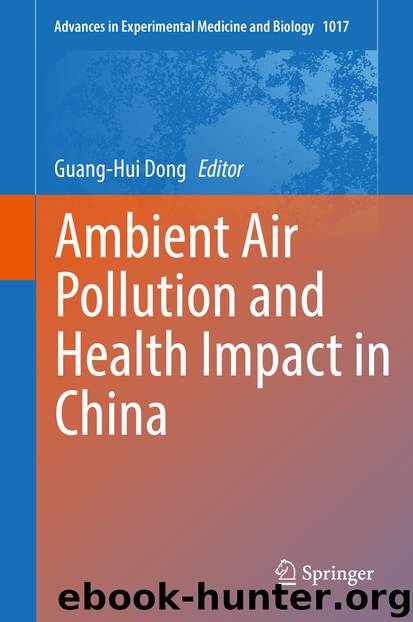Ambient Air Pollution and Health Impact in China by Guang-Hui Dong

Author:Guang-Hui Dong
Language: eng
Format: epub
Publisher: Springer Singapore, Singapore
6.3.3 Ambient Air Pollution and Hypertension
As the major risk factor for cardiovascular disease (CVD) and other vascular diseases [29, 48, 73], high blood pressure (BP) and hypertension have been identified as the most important causes of disability and the leading risks for death in the world, causing an estimated 7.5 million deaths per year (13% of all deaths) [72]. To investigate the association between residential long-term exposure to air pollution and BP and hypertension, 33 communities study recruited 24,845 Chinese adults in 11 districts of 3 northeastern cities from 2009 to 2010 [14] (Fig. 6.4). High ambient pollution levels were observed in the 11 study districts. The arithmetic means of PM10, SO2, NO2, and O3 were 123.1, 54.4, 35.3, and 49.4 μg/m3, respectively. These mean concentrations presented a wide variation in district gradient for PM10 (93–145 μg/m3), SO2 (36–78 μg/m3), NO2 (27–45 μg/m3), and O3 (27–71 μg/m3). Results revealed that the odds ratio (OR) for hypertension elevated by 1.12 (95% confidence interval [CI], 1.08–1.16) per 19 μg/m3 increase in PM10, 1.11 (95% CI, 1.04–1.18) per 20 μg/m3 increase in SO2, and 1.13 (95% CI, 1.06–1.20) per 22 μg/m3 increase in O3. Estimated increases in mean systolic and diastolic BP were 0.87 mmHg (95% CI: 0.48–1.27) and 0.32 mmHg (95% CI: 0.08–0.56) per 19 μg/m3 interquartile rise in PM10, 0.80 mmHg (95% CI: 0.46–1.14) and 0.31 mmHg (95% CI: 0.10–0.51) per 20 μg/m3 interquartile increase in SO2, and 0.73 mmHg (95% CI: 0.35–1.11) and 0.37 mmHg (95% CI: 0.14–0.61) per 22 μg/m3 interquartile increase in O3. Additionally, these associations were statistically significant only in men. Furthermore, the authors also evaluated whether obesity modified the association between ambient air pollution and increased blood pressure and hypertension in adults [89]. For all participants, significant interactions between being overweight and obese with PM10 or O3 (P < 0.001) were observed. However, when stratified by gender, these relationships were only obtained in males. Among men, the effects of air pollutants on hypertension were strongest in obese subjects (OR ranged from 1.27 to 1.49), less strong in overweight subjects (OR ranged from 1.09 to 1.24), and weakest in normal-weight subjects (OR ranged from 1.08 to 1.10). Among women, none of the pollutants were found to be associated with prevalence of hypertension within any subgroup. As for arterial BP, for all subjects, each of the ambient air pollutants, except for NO2, was significantly associated with higher SBP and DBP levels and increasing BMI; this association was especially seen in SBP. When stratified by gender, these significant relationships were also limited to men [89]. Lin et al. [34] recently also examined long-term association between ambient PM2.5 and hypertension and blood pressure by interviewing 12,665 participants aged 50 years and older and measuring their blood pressures. Annual average PM2.5 concentrations were estimated for each community using satellite data. For each 10 μg/m3 increase in ambient PM2.5, the adjusted odds ratio of hypertension was 1.14 (95% confidence interval, 1.07–1.22). Stratified analyses found that overweight and obesity could enhance the association and consumption of fruit was associated with lower risk.
Download
This site does not store any files on its server. We only index and link to content provided by other sites. Please contact the content providers to delete copyright contents if any and email us, we'll remove relevant links or contents immediately.
| Administration & Medicine Economics | Allied Health Professions |
| Basic Sciences | Dentistry |
| History | Medical Informatics |
| Medicine | Nursing |
| Pharmacology | Psychology |
| Research | Veterinary Medicine |
Good by S. Walden(3467)
The Social Psychology of Inequality by Unknown(2921)
0041152001443424520 .pdf by Unknown(2764)
The Checklist Manifesto by Atul Gawande(2760)
The Meaning of the Library by unknow(2485)
Guns, Germs and Steel by Diamond Jared(2272)
Borders by unknow(2199)
23:27 by H. L. Roberts(2184)
And the Band Played On by Randy Shilts(2111)
Being Mortal: Medicine and What Matters in the End by Atul Gawande(2068)
A Leg to Stand On by Oliver Sacks(1987)
Get What's Yours for Medicare: Maximize Your Coverage, Minimize Your Costs by Philip Moeller(1975)
The Hot Zone by Richard Preston(1964)
The Valachi Papers by Peter Maas(1800)
The Laws of Medicine by Siddhartha Mukherjee(1727)
The Andromeda Strain by Michael Crichton(1681)
The Obesity Epidemic by Robyn Toomath(1637)
Pharmacy Practice and The Law by Richard Abood(1529)
Autism's False Prophets by Paul A. Offit(1481)
